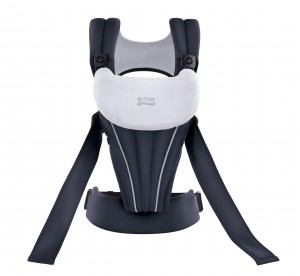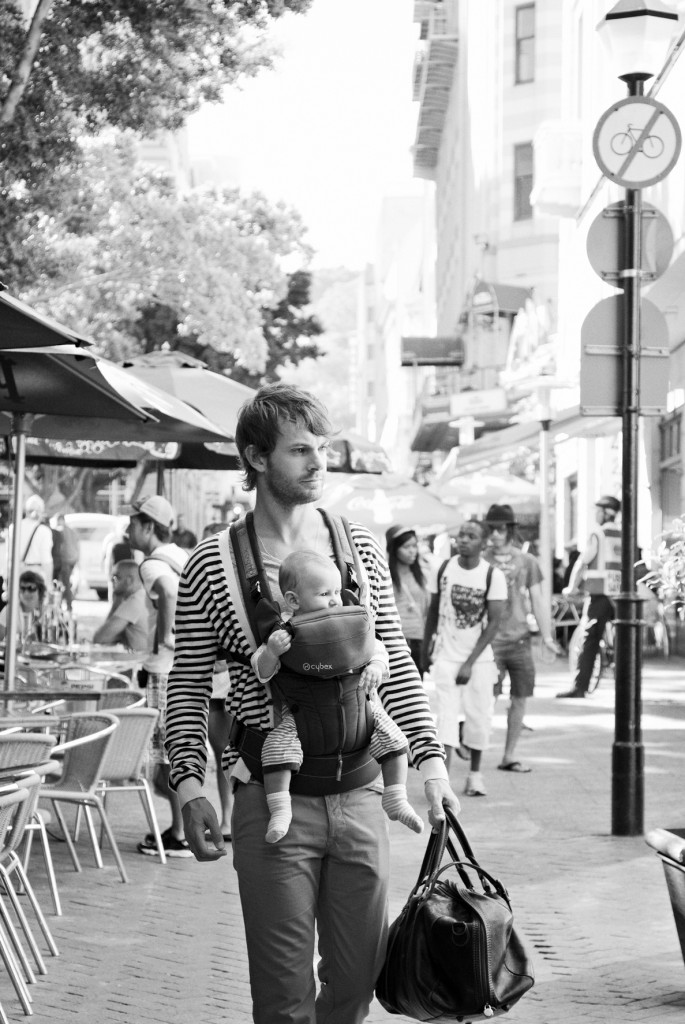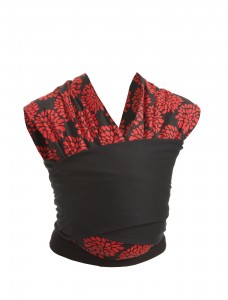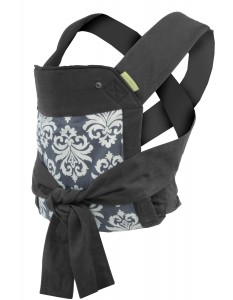
Know you want to keep baby close, but not sure which carrier is right for you? Here’s our take on some of the best on the market.
Keeping baby close is a natural desire as both mom and baby wean themselves from three trimesters of very close proximity. For the newborn, baby carriers ease the transition by keeping baby snug, safe and close enough to experience mom’s scent, warmth and heartbeat. This bonding time has been shown to provide numerous benefits, from lessening crying to helping new parents be more in tune with baby’s needs, including boosting milk production. And, as Michal Chesal, the mom at the head of Baby K’tan, adds, “the benefit not mentioned nearly enough is the exceptionally close relationship a baby carrier can foster between baby and dad.” This is something I can personally attest to as my husband was scoping out baby carriers by the second trimester and could not wait to finally get his turn at holding baby close.
Of course, carriers provide another very practical and key benefit that many of us take for granted before becoming parents: free hands! Whether you’re trying to wash dishes, answer a few emails, get in a little exercise or just feed yourself, a carrier will be your favorite piece of gear, allowing you to be fully functional again– or as close to that as possible with a baby in tow.
For trips out of the house, baby carriers take you places that strollers can’t easily maneuver. Great for hikes, narrow store aisles or urban environments with uneven pavement, carriers make it easy get out and about. Need to hop in the car? Carriers are also easier to pack up and throw in your trunk, making them extremely portable even when not in use.
Because they don’t take up a lot of room, many families opt for multiple carriers, choosing one for short wears and another for extended use. Others evolve from carriers that better cradle a newborn to ones that support heavier weights while being kind to mom’s shoulders and back. In addition, many buy multiples so that both parents can partake in baby carrying while wearing one that best suits his or her personal needs, whether that be in dimension or aesthetic style.
“Parents and cultures may be different, but little babies all have the same need for closeness to their parents,” says Björn Jakobsen, founder of BabyBjörn. To meet this need, forms of baby carriers have been around for centuries. However, it’s only been in recent decades that carriers have fully taken off in the U.S., with baby carriers now a standard item on any expectant parent’s wish list. Today’s parents can find a myriad of choices in several distinct styles. The sling is typically a single looped piece of fabric that hangs over a shoulder and forms a pouch to cradle baby. A wrap is a long swath of fabric that (you guessed it) wraps around your body to hold baby close. Mei tais descend from the Chinese tradition of carrying baby using a square panel of fabric with straps emerging from each corner for tying around mom or dad. And, last but certainly not least, the soft-structured carrier is the form that many parents are most familiar with today as a padded pouch with shoulder straps, belts and buckles to help lighten the load and facilitate the process of baby wearing.
Now that you’ve got the basics down, here are some of the top carriers on the market that may be just what you’re looking for to stay close to baby while keeping up with daily life.
Baby K’tan
Moby Wrap
Infantino EcoSash Wrap & Tie Carrier
BabyBjorn Baby Carrier Miracle
BabyBjorn Baby Carrier Original
Infantino Sync Comfort Wrap Carrier
ErgoBaby Original Bundle of Joy
Belle Organic Jubilee
CYBEX 2.GO
Infantino Support Ergonomic Cotton Carrier
Infantino Flip Soft Comfort Carrier
Britax Baby Carrier
Front Snugli Herringbone Carrier
CARRIER checklist
Whether you want a carrier to let you do household chores, go on quick trips out of the house or simply dance with your baby around the living room, here are the quick facts of what you need to know when choosing a baby carrier.
1. Types of Baby Carriers
SLINGS
Looped fabric that hangs over your shoulder(s) and can hold baby in a cradled position, upright front positions, on the hip or on the back. Some must be sized specifically for an individual wearer, as they consist of a single piece of fabric arranged as a pouch, while others include a ring for adjusting to different wearers.
WRAPS
A long swath of fabric that wraps around the body and holds the baby in front, hip or back positions. Stretchy fabrics hold younger infants closer, while woven fabrics hold the weight of older babies. Wraps can require a bit of a learning curve to get the wrapping and tying technique down, but once mastered can be incredibly comfortable.
MEI TAIS
Borrowed from the traditional Chinese method of carrying a baby, this carrier includes a cloth panel with shoulder and waist straps and may include extras like head support or sleeping hoods. These carriers often skip the belts and buckles and involve tying straps to position baby on your front or back.
SOFT-STRUCTURED CARRIERS
Designed for an ergonomic fit that distributes weight to the shoulders, waist and back, these carriers combine a shaped body panel with straps, belts and buckles to simplify the process of putting this carrier on and adjusting it to fit you and your child. Depending on the model, these can be used for front, side or back carrying.
2. Questions to ask yourself
• Are you planning to use the carrier as soon as baby is born? Do you mind if you need to purchase a separate infant insert to use until your baby can hold herself upright?
• What are your preferred carrying positions—cradled, front facing in, front facing out, on your hip or on your back? (Babies can face forward when their neck muscles are strong enough to hold their heads up—typically around 4 months.)
• How long do you plan to use your carrier? Even if some carriers can accommodate higher weight limits, can you physically carry a child into her toddler years?
• Is climate an issue? Well-padded carriers feel great but can cause you or baby to heat up quickly if they aren’t of a material that breathes well or wicks away moisture.
• Is this carrier just for you or does it need to be easily adjusted to fit your partner as well?
3. Find the carrier that’s best for you and your baby. Check the features you need most in a baby carrier in the first column. Write notes in the last 3 columns to compare models you’re considering.
|
FEATURE |
KEY TO ME |
STROLLER _________ |
STROLLER _________ |
STROLLER _________ |
|
Ability to hold a newborn: Do you mind if it requires an additional insert? |
|
|
|
|
|
Weight limit: Are you hoping this will last through the toddler years? |
|
|
|
|
|
Fabric cut: Does your child fit snugly? Perhaps too snugly with little room to move? |
|
|
|
|
|
Carrying positions: Do you prefer cradle position, front facing in/out, back or hip? |
|
|
|
|
|
Portability when not in use: Padding feels great, but adds bulk that makes it hard to pack the carrier in a bag. Can you wear the carrier when not in use or do the straps drag? |
|
|
|
|
|
Right fabric weight for local climate? |
|
|
|
|
|
Easy to adjust: especially important if you’re sharing with a partner |
|
|
|
|
|
Comfort: Does the carrier have padded straps and belts? |
|
|
|
|
|
Weight distribution: How well is weight split between hip, back and shoulders? |
|
|
|
|
|
|
|
|
|
|
|
ADDED EXTRAS OR ADD-ONS: |
|
|
|
|
|
Detachable dribble bib |
|
|
|
|
|
Sleep hood |
|
|
|
|
|
Ability to nurse while baby is in the carrier |
|
|
|
|
|
Style: Carriers come in a variety of colors and patterns |
|
|
|
|
• What activities do you hope to use the carrier for? For quick tasks around the house, you may care less about ergonomics and more about how easily you can slip baby in and out of the carrier. Use for longer trips may be worth extra straps and buckles that make carrying more comfortable.
• Will you need to get your baby into and out of the carrier by yourself or will you have someone there to assist you? This is especially important for backpack position, which often requires help.
• Which carrier fits you best? While you can read reviews and watch videos online, nothing beats going to the store and trying carriers on. Different carriers suit different body types and you never really know which you may like best until you’ve had the chance to strap a few on. If possible, try these on before you’re too pregnant so that you can get a real feel for what these carriers will be like on a baby bump-free body.






Leave a Reply